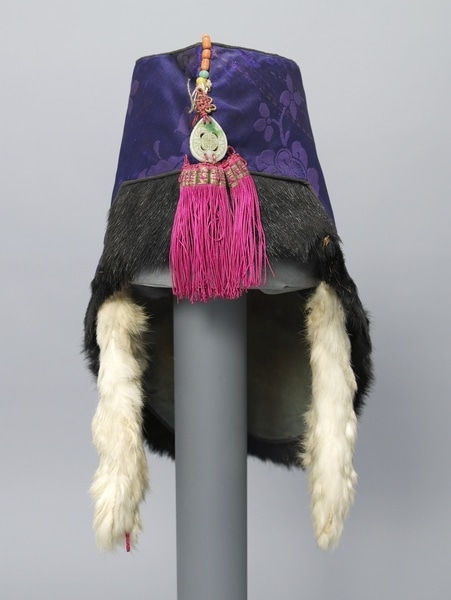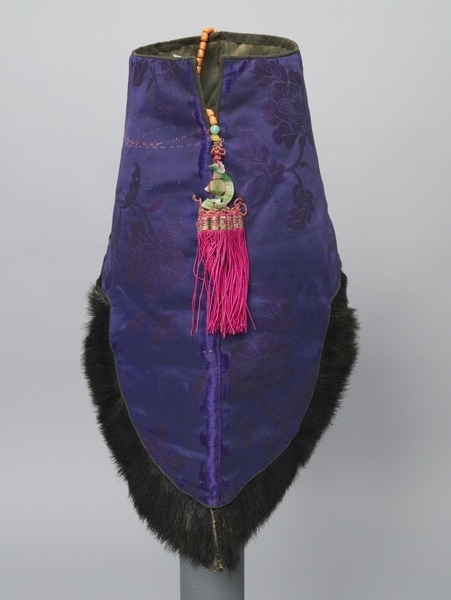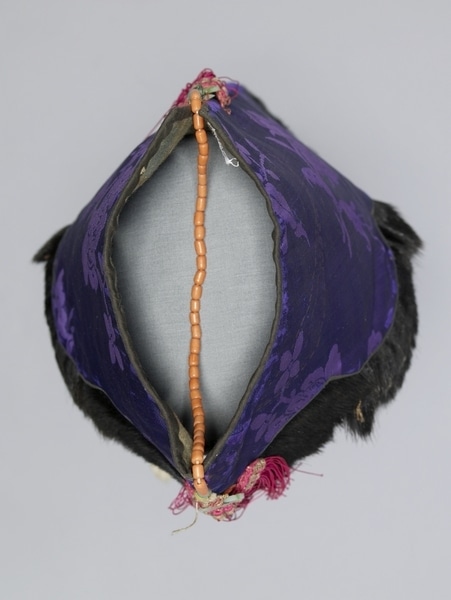Open-top Hood Item Number: Ed1.289 from the MOA: University of British Columbia




Description
Open-top hood made of purple floral-patterned silk damask with added ear-flaps of fuschia silk damask lined with white rabbit fur, with a loop at the end of one and embossed brass button at the end of the other. The hood is constructed of two halves sewn together at the centre of the forehead and centre back, but with an opening at the top edged with black piping ending with a short slit at the back. The hood is cut straight across the forehead with two deep scallops edged with black piping on each side. It is edged entirely with two layers of skin with black fur, one facing inside and the other facing outside.. A string of coral-coloured beads crosses the opening from front to back, ending in a broken jade disk at the back, below which are seven pink tassels wrapped in silver thread. At the front there an elaborate knot of gold cord, below which is a teardrop shaped piece of jade, below which are nine pink tassels wrapped in silver thread. The hood is lined with dull green cotton flannel.
History Of Use
In the later Chosun Dynasty, such hoods were used for both men and women. Those of purple or deep blue fabric were for women. Those with detailing such as jade ornaments and coral beads were worn by high-class women of the official “Yangban” class. Ordinary people just wore ear covers held in place with a cord. These hoods were open at the top for ventilation, so the wearer would not catch cold because of the difference between her body heat and the outdoor temperature. The ear flaps could be fastened under the wearer’s chin. Hoods of this type came from the northern part of Korea. Ones that were very finely sewn were made in shops.
Specific Techniques
The hood is made with fine hand sewing.
Iconographic Meaning
The colour of the body of the hood shows that it was for a woman. The odd number of tassels represents good fortune.
Item History
- Made in Korea during 1930
- Owned by Hi Soon Kim before June 21, 1983
- Received from Hi Soon Kim (Seller) and Museum of Anthropology Shop Volunteers (Funding source) on June 21, 1983
What
- Name
- Open-top Hood
- Identification Number
- Ed1.289
- Type of Item
- hood
- Material
- silk fibre, cotton fibre, rabbit skin, skin, dye, jade mineral ?, coral, glass ?, silver metal, gold metal and brass metal
- Manufacturing Technique
- cut, tanned, dyed, sewn, carved and wrapped
- Overall
- height 36.0 cm, width 32.0 cm
Who
- Culture
- Korean
- Previous Owner
- Hi Soon Kim
- Received from
- Hi Soon Kim (Seller) and Museum of Anthropology Shop Volunteers (Funding source)
Where
- Holding Institution
- MOA: University of British Columbia
- Made in
- Korea
When
- Creation Date
- during 1930
- Ownership Date
- before June 21, 1983
- Acquisition Date
- on June 21, 1983
Other
- Item Classes
- textiles
- Condition
- fair
- Accession Number
- 0894/0006